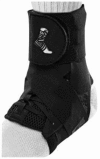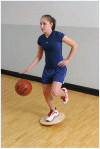Basketball coaches' utilization of ankle injury prevention strategies
- PMID: 24427411
- PMCID: PMC3752192
- DOI: 10.1177/1941738113491072
Basketball coaches' utilization of ankle injury prevention strategies
Abstract
Background: Ankle injuries are the most common high school basketball injury. Little is known regarding the utilization of ankle injury prevention strategies in high school settings.
Objective: To determine high school basketball coaches' utilization of ankle injury prevention strategies, including prophylactic ankle bracing (PAB) or an ankle injury prevention exercise program (AIEPP).
Study design: Cross-sectional survey.
Methods: The survey was distributed to all high school basketball coaches in Wisconsin. Fisher exact and Wilcoxon rank sum tests were used to determine if the injury prevention strategies utilized differed according to school size, sex of the team, years of coaching experience, and the coach's education level.
Results: Four hundred eighty (55%) coaches from 299 (74%) high schools completed the survey. Thirty-seven percent of the coaches encouraged or required their players to use PAB. School enrollment of the coaches' teams did not affect their stance on the use of PAB (P = 0.30), neither did the sex of the team (P = 0.16), years coaching (P = 0.09), nor the coach's education (P = 0.49). Fifty percent (n = 242) of the coaches indicated they do not utilize an AIEPP, with no difference based on school enrollment (P = 0.47), team sex (P = 0.41), years coaching (P = 0.78), or the education level (P = 0.44). Barriers to utilization of AIEPP included a lack of time, awareness, and expertise. Coaches preferred an AIEPP that was specific to basketball, combined injury prevention and performance enhancement components, was performed 2 to 3 days per week, and lasted 5 to 15 minutes.
Conclusion: Less than half of the coaches encouraged use of PAB, and half did not utilize an AIEPP. Coaches had specific preferences for the type of AIEPP they would implement.
Clinical relevance: Sports medicine providers should promote ankle injury prevention strategies but need to address why prevention strategies may not be utilized in high school basketball settings.
Keywords: ankle injury; basketball; high school; prevention.
Conflict of interest statement
The authors report no potential conflicts of interest in the development and publication of this manuscript.
Figures






References
-
- Borowski LA, Yard EE, Fields SK, Comstock RD. The epidemiology of US high school basketball injuries, 2005-2007. Am J Sports Med. 2008;36:2328-2335 - PubMed
LinkOut - more resources
Full Text Sources
Other Literature Sources

